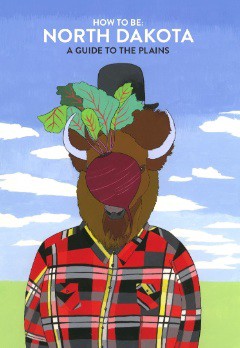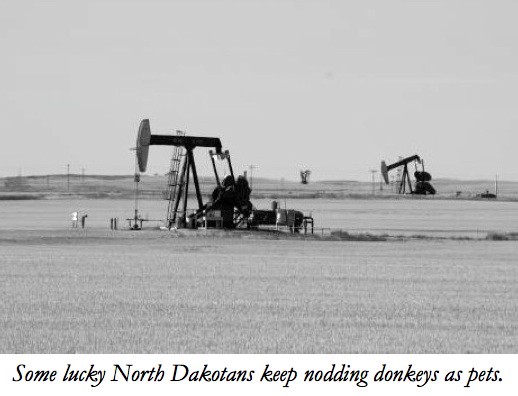Excerpts From 'How to Be: North Dakota'
by Abe Sauer

How to Be: North Dakota — A Guide to the Plains is out now (and psst, costs only $8.95). The book, which features illustrations by Amy Jean Porter, would make a great holiday gift for anyone “who has looked at the vast expanse of Ole and Lena jokes and asked, ‘Is that it?’”
HOLIDAYS, CUSTOMS AND UDDER STUFF
Naugahyde
While its use peaked in the rest of America in the early 1970s, the tanned skin of the wild nauga remains popular in North Dakota.
Bison vs. Buffalo
Buffalo, home to terrible pro-sports teams, is an industrial wasteland in New York State. A Bison is the mascot of a North Dakota university sports team in the social wasteland of Fargo. Both are delicious in burger form.
“Minnesota Nice”
A more common term for the passive aggressive behavior of the residents to the east, who really deserve credit for doing so well, considering.
Supper
One pea more than “super” is supper! The last official meal of the day, supper is what east coast elitists call “dinner.”
Sundogs
Also known as a “phantom sun” or a “parhelion.” A prairie phenomenon that occurs during sunsets when a bright blaze of light at 22°, the same distance above the horizon as the sun, gives the appearance of a second sun. If you see one, you owe George Lucas royalties.
Sodbuster
Farmers in the late 1800s who moved into the Great Plains to work the pristine expanse of prairie. Their nickname came from the way they busted up the sod to plant crops. Sodbusters shared a name with “union busters,” another popular late- 1800s vocation.
The Food Security Act of 1985 gave sodbusters a bad name, using the term as the name of a provision that penalized the plowing up of certain grasslands. These lands were named “highly erodible lands” by the US Dept. of Agriculture, leading to government papers with titles like “More HEL is in compliance.”
Each summer, Fort Ransom in Ransom County hosts Sodbuster Days. Some North Dakotans still think of themselves as sodbusters, though the stone-sharpening art of flintknapping has fallen off in popularity recently in favor of plain old napping.
Berm
A level, sometimes raised, barrier of grass area between the sidewalk and the road. Yes, you also have to mow that.
Euphorbia esula
Better known as “leafy spurge,” or by its scientific name “That Damn Weed that Just Won’t Die,” euphorbia esulaan is an invasive plant characterized by white milky sap. An invasive immigrant species, leafy spurge moves into an area and takes all of the jobs that would otherwise go to native weeds.
Nodding Donkey
Commonly seen in western North Dakota, a “nodding donkey” is the above ground pumpjack portion of a reciprocating piston pump oil well. This term is derived from the pump’s seesawing, in-and-out motion, leading to its other nicknames “grasshopper pump,” “thirsty bird” and “Yo’ Mamma’”

In the eastern portion of the state, a “nodding donkey” is an incumbent Democrat.
Hotdish
A hotdish is a baked casserole consisting of some kind of meat, some kind of starch, and some vegetable mixed with a canned soup and baked to a golden brown at some kind of temperature. For example, tater tots, hamburger, frozen peas and a can of cream of mushroom soup is a perfect hotdish. The hotdish forms the wide, heavy foundation of the North Dakota food pyramid. Eaten often enough it forms the wide foundation of the heaviest North Dakotans. The hotdish also serves as a peace offering between family members who hate each other.
Alberta Clipper
Sudden, unpredictable burst of harsh weather that comes down from Canada to tear through North Dakotan cities. Not to be confused with “Alberta trippers,” a weekend burst of Canadians come down to tear through North Dakotan big box stores. Alberta Clippers are often confused with “Alberta strippers” as both can cause great monetary damage.
Syttende Mai
Also known as Norwegian Constitution Day. May 17 celebrates the day Norway’s founding fathers plagiarized the greatest document in the world for their own freedom and liberty and then all shared a hotdish just like a bunch of socialists. In re- cent years, Syttende Mai has become especially popular with the Scandinavian Tea Party, also known as the Glögg Pärty.
***

SQUARE DANCE!
Like polio and Flag Day, square dancing was largely eradicated in America by the late 20th century. Yet, a healthy number of square dancing groups still operate in the state, where it is the official dance.
American square dancing is derived from the folk dances of numerous immigrant cultures, including those of the British, Caledonians, and Skuares, a forgotten culture known for its inability to make anything but a right turn.
From the beginning, the dance was controversial.
In 1923, the popularization of the square dance move “Allemande Left,” led to harsh punishment by the House Committee on Un-American Activities.
Many religious leaders have forbidden square dancing for its similarity to sex. Sexually transmitted dances are common.
As with many things North Dakotan, the name, “square- dance,” wastes nothing. It at once describes the motion through which the dance is performed while at the same time describing the social position of those performing it.
Square dancing is generally made up of movements using an eight count, with each dance consisting of a set of moves for the dancers to follow. Typical square dance choreography is comprised of four parts called A1, A2, B1, and B2. A count is one half of a musical measure, or a quarter note in 2/4 time, also a three-eighth note in 6/8 time. It is also a dude from old Europe who may or may not drink your blood.
The “caller” calls the dance by describing directions to the dancers through coded square dance terms. Typical terms include: allemande; butterfly whirl; do-si-do; promenade: sashay; and ladies chain (not to be confused with Ladies Chain™, a line of pornographic videos).
In some ways, square dance callers are the original free-form rap artists. In almost every other way they are not.
Some classic examples of calls that would make up a dance:
Allemande left, with the corner maid; meet your own and promenade.
Cat in the barn, rat in her mouth Grab your honey and head her south.
Ambulances and big black hearses; swing those doctors; swing those nurses.
Bow to you partner and the corner miss; to the opposite lady, just blow a kiss.
If you like this book so might your brother; then open that wallet and buy a-nother.
***
NoDaktivity: Spot the Difference on Highway 2

Can you spot the four differences between these two pictures of traffic on Highway 2 during a blizzard?
ANSWERS
1) The truck carrying a load of potatoes in Picture 1 is carrying beets in Picture 2.
2) The Pontiac driver in Picture 1 has a blood alcohol level of .04. In Picture 2 it is .19.
3) It is night in Picture 2.
4) In Picture 2 there is a deer directly in front of your car. It is not there in Picture 1.
Born and raised on a dairy farm in the Midwest, Abe Sauer splits time between North Dakota, Minnesota and Wisconsin. One of his daughters was born in North Dakota, the other is North Dakotan in spirit. He’s a columnist for The Awl and has written for Esquire, The Atlantic and The St. Paul Almanac, among others. He tweets the Midwest on Twitter.
